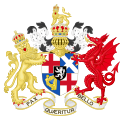Lord Protector of England
| Lord Protector of England, Scotland and Ireland | |
|---|---|

|
|
| Style | His Highness |
| Residence | Palace of Whitehall |
| Appointer | Hereditary |
| Formation | 16 December 1653 |
| First holder | Oliver Cromwell |
| Final holder | Richard Cromwell |
| Abolished | 25 May 1659 |
Lord Protector (pl. Lords Protector) is a title that has been used in British constitutional law for head of state. It is also a particular title for the British heads of state in respect to the established church. It is sometimes used to refer to holders of other temporary posts, for example, a regent acting for the absent monarch.
The title of 'The Lord Protector' was originally used by royal princes or other nobles exercising an individual regency (i.e. not merely as a member of a collegial regency council) while the English monarch was still a minor or otherwise unable to rule.
Notable cases in England are:
and in Scotland:
The Lord Protector of the Commonwealth of England, Scotland and Ireland was the title of the head of state during the Commonwealth (or, to monarchists, the Interregnum), following the first period when a Council of State held executive power. The title was held by Oliver Cromwell (December 1653 – September 1658) and subsequently his son and designated successor Richard Cromwell (September 1658 – May 1659) during what is now known as The Protectorate.
The 1653 Instrument of Government (republican constitution) stated that—
Oliver Cromwell, Captain-General of the forces of England, Scotland and Ireland, shall be, and is hereby declared to be, Lord Protector of the Commonwealth of England, Scotland and Ireland, and the dominions thereto belonging, for his life.
The replacement constitution of 1657, the Humble Petition and Advice, gave "His Highness the Lord Protector" the power to nominate his successor. Cromwell chose his eldest surviving son, the politically inexperienced Richard. This was a non-representative and de facto dynastic mode of succession, with royal connotations in both styles awarded, (even a double invocation 16 December 1653 – 3 September 1658 "By the Grace of God and Republic Lord Protector of England, Scotland and Ireland") and many other monarchic prerogatives, such as that of awarding knighthoods.
...
Wikipedia

